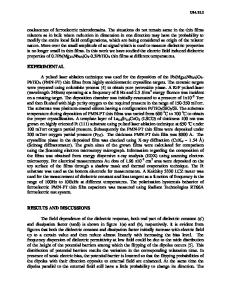Relaxor Pb(Mg l/3 Nb 2/3 )O 3 Thin Films: Processing, Dielectric and Electrostrictive Properties
- PDF / 848,590 Bytes
- 6 Pages / 417.6 x 639 pts Page_size
- 89 Downloads / 383 Views
523 Mat. Res. Soc. Symp. Proc. Vol. 596 © 2000 Materials Research Society
A translucent PMN gel was obtained by hydrolysis of some of the precursor solution at room temperature. Thermogravimetry (TGA) and differential thermal analysis (DTA) of the gel were done in oxygen at a heating rate of 5°C/min. Film deposition was carried out by spin-coating at 2500 rpm for 40 s. After pyrolysis of the layers at 400'C for 30 s on a hot-plate, rapid thermal anneals at 800-850'C with short holding times on the order of 30 sec were employed to crystallize the perovskite phase. Seeding layers, sputtered 2-nm-thick TiO 2 and 10-nm-thick PbTiO 3 seed layers, were deposited by magnetron sputtering on the strongly [111] textured platinum bottom electrode. The film microstructures were investigated by x-ray diffraction, scanning electron microscopy and transmission electron microscopy. To perform the dielectric measurements, an impedance analyzer and a chamber with controlled heating and cooling rates were used. The sample temperature was measured with a Pt 100 probe. A modified Mach-Zender laser interferometer 10 was used for the piezoelectric and electrostrictive strain measurements. RESULTS AND DISCUSSION Dried gel properties Figure 1 illustrates TGA and DTA analysis of a PMN dried gel. The first broad endothermic peak between 40'C and 180'C is due to removal of residual alcohols and by-products. In the temperature window between 200'C and 400'C an endothermic peak at about 200'C and an exothermic peak at 280 'C overlap. These two peaks can be attributed respectively to the departure of hydroxyl groups from subsequent condensations and combustion of remaining alkyl groups. Xray data as well as more detailed thermal analysis show that the transformation of several intermediate phases into the final perovskite phase is more complex than displayed in Figure 1. Here 0 only the largest of the PMN perovskite crystallization endotherms can be seen starting at 750 C
0
_5z
J..
- ... . .. ..
-20
~ENDO 0
200 600 1000 Temperature [°C]
FIGURE 1: Differential thermal analysis (DTA) and thermal gravimetry (TGA) curves of PMN dried gel (heating rate: 5°C/min) Substrate influence on nucleation and crystallization The present study clearly demonstrated that the substrate and the use of different seeding layers strongly influenced the quality and crystallographic orientation of PMN perovskite thin films. At present PMN films fabricated directly on platinized silicon showed large amounts of second phases and poor electrical properties. However, the use of different oxide seeding layers not only allowed us to process phase pure PMN perovskite but also to control their crystallographic orientation. The influence of sputtered nucleation layers has already been shown for sputtered'1-13 and solution derived Pb(Zr,Ti)0 3 thin films.'V
524
The effect of different seeding layers is shown in Figure 2. Two PMN films were crystallized at 810 0 C for 30 s on Pt/TiO2 /SiO 2/Si substrates: For film (A) a 2 nm thick sputtered TiO 2 seed layer was used,
Data Loading...











